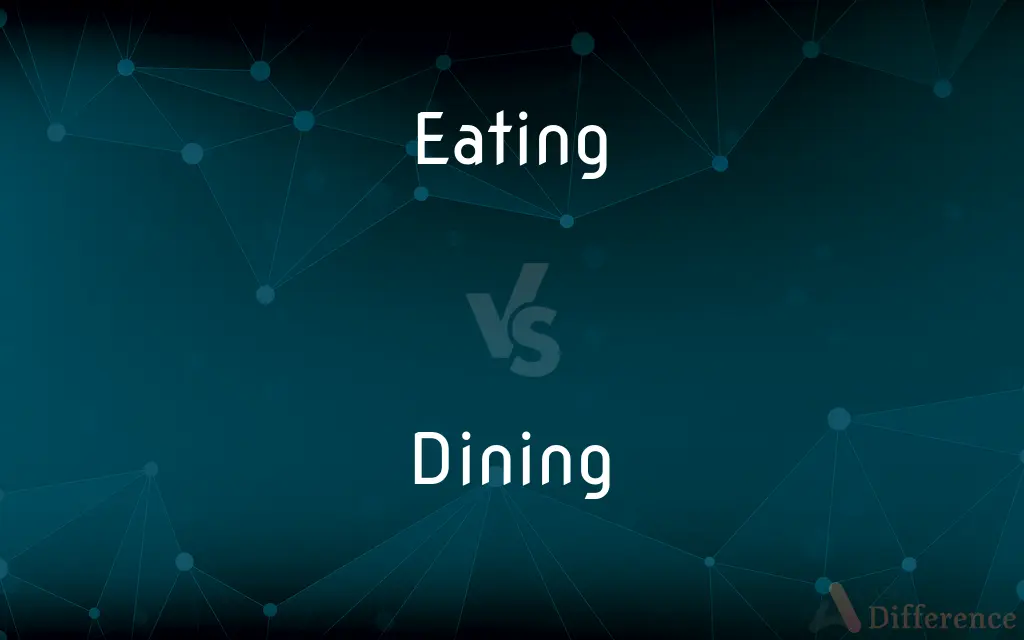Eating vs. Dining — What's the Difference?
By Maham Liaqat & Fiza Rafique — Updated on March 20, 2024
Eating refers to the basic act of consuming food for sustenance, focusing on the intake of nutrients. Dining, however, implies a more elaborate and social experience, often involving multiple courses and etiquette.

Difference Between Eating and Dining
Table of Contents
ADVERTISEMENT
Key Differences
Eating is the fundamental process of consuming food to fulfill bodily needs for energy and nutrients. It's an essential activity that can be simple and casual, like grabbing a quick snack. On the other hand, dining is a more refined and social activity, usually taking place in a more formal setting, such as a restaurant or a dinner party, where the focus is not just on the food but also on the experience, ambiance, and the company of others.
When eating, the primary goal is to satisfy hunger and nutritional requirements. This can be a solitary and quick activity, with minimal emphasis on the setting or the manner of eating. Whereas dining is often a communal experience, where individuals gather to enjoy a meal together, fostering social connections and conversations. The atmosphere, presentation of food, and adherence to certain etiquettes play significant roles in dining.
Eating can involve a wide range of foods and does not necessarily adhere to a structured pattern of courses. One might eat a sandwich on the go or have a bowl of cereal for breakfast. Dining, however, often involves a sequence of courses, starting with an appetizer, followed by the main course, and concluding with dessert, each paired with appropriate beverages, enhancing the overall gastronomic experience.
In the context of eating, convenience and speed can be key factors, especially in today's fast-paced lifestyle. Meals might be pre-packaged or fast food, consumed quickly to return to daily tasks. In contrast, dining is characterized by a leisurely pace, where individuals take time to savor each dish, engage in lengthy conversations, and enjoy the culinary artistry, turning a meal into a memorable event.
The act of eating is universal and can occur in various settings, from a desk at work to a quick bite in a car. Dining, however, usually implies a specific setting designed for meals, such as a dining room, a restaurant, or an outdoor setting arranged for a special occasion, where the environment contributes to the dining experience.
ADVERTISEMENT
Comparison Chart
Focus
Sustenance and nutrition
Experience, ambiance, and socializing
Setting
Casual, can be anywhere
More formal, specific settings
Food
Simple, quick, and functional
Often elaborate, multiple courses
Pace
Can be quick, focused on efficiency
Leisurely, with emphasis on enjoyment
Social Aspect
Can be solitary
Inherently communal and conversational
Etiquette
Minimal, focused on practicality
More defined, with attention to manners
Compare with Definitions
Eating
Eating involves consuming food to satisfy hunger and nutritional needs.
She was eating an apple on her way to work.
Dining
Dining is a more formal experience, often enjoyed with others.
They were dining at a fancy restaurant to celebrate their anniversary.
Eating
It can be a quick, solitary activity without formalities.
For lunch, he was eating a sandwich at his desk.
Dining
It includes multiple courses and a focus on the culinary experience.
Dining at the new Italian place, they enjoyed a three-course meal.
Eating
Eating can be informal and spontaneous, without a set structure.
They were eating leftovers for dinner.
Dining
It's an opportunity for social interaction and celebration.
The family was dining together on Thanksgiving, sharing stories and laughter.
Eating
Eating is essential for survival, focusing on intake of nutrients.
Eating a balanced diet is crucial for good health.
Dining
Dining emphasizes the ambiance and setting as part of the experience.
They were dining under the stars at the beachside resort.
Eating
The act of eating is a daily necessity, often done several times a day.
She was eating breakfast before sunrise.
Dining
Dining follows certain etiquettes and manners, enhancing the experience.
During the formal dining event, everyone adhered to the etiquette.
Eating
Eating (also known as consuming) is the ingestion of food, typically to provide a heterotrophic organism with energy and to allow for growth. Animals and other heterotrophs must eat in order to survive — carnivores eat other animals, herbivores eat plants, omnivores consume a mixture of both plant and animal matter, and detritivores eat detritus.
Dining
The activity of eating a meal
The city has become a capital of fine dining
A dining area
Eating
Suitable for being eaten, especially without cooking
Good eating apples.
Dining
To have dinner.
Eating
Used in the ingestion of food, as at the table
Eating utensils.
Dining
To give dinner to; entertain at dinner
Wined and dined the visiting senators.
Eating
Bred to be eaten.
Eating chickens; eating quails
Dining
Eating dinner as a social function.
Eating
Suitable to be eaten without being cooked.
Wait! That's not an eating apple.
Dining
Entertaining someone to dinner.
Eating
The act of tasking food; the act of consuming or corroding.
Dining
Present participle of dine
Eating
Something fit to be eaten; food; as, a peach is good eating.
Dining
The act of eating dinner
Eating
The act of consuming food
Common Curiosities
What is the main difference between eating and dining?
The main difference lies in the context and experience; eating is about consuming food for sustenance, while dining is a more elaborate and social experience.
Do all cultures have the same dining etiquettes?
No, dining etiquettes can vary greatly across cultures, reflecting different traditions and social norms.
Is it possible to dine alone?
While dining is often social, it's possible to dine alone, especially in a formal setting or a restaurant, focusing on the culinary experience.
Can fast food be considered dining?
Fast food is generally associated with eating due to its focus on convenience and speed, rather than the dining experience.
Is dining always expensive?
Dining doesn't always have to be expensive; it can be affordable yet still provide a pleasant and formal experience.
Can dining be considered a form of eating?
Yes, dining is a form of eating that is more formal and focused on the experience and social aspect.
Why is dining considered a social activity?
Dining encourages conversation and interaction, making it an inherently social activity that strengthens bonds.
How does one's culture influence their dining habits?
Cultural background can significantly influence dining habits, from the types of food eaten to the manners observed during meals.
Is cooking at home considered dining?
Cooking and eating at home can be considered dining if it involves a formal setup, multiple courses, and a focus on the experience.
How important is service in a dining experience?
Service quality is crucial in dining, affecting the pace, comfort, and enjoyment of the meal.
How does the ambiance influence dining?
The ambiance plays a crucial role in dining, enhancing the overall experience through music, decor, and lighting.
Can dietary restrictions be accommodated in dining?
Yes, many dining establishments cater to various dietary restrictions and preferences.
Can dining be a form of entertainment?
Yes, dining can be a form of entertainment, especially in settings where the preparation or presentation of food is part of the experience.
Does dining have to involve multiple courses?
While multiple courses are common in dining, it's not a strict requirement; the focus is more on the quality and experience of the meal.
What role does presentation play in dining?
In dining, presentation enhances the appeal and perceived quality of the food, contributing to the overall experience.
Share Your Discovery

Previous Comparison
Nuts vs. Legumes
Next Comparison
Canonicalised vs. CanonicalizedAuthor Spotlight
Written by
Maham LiaqatCo-written by
Fiza RafiqueFiza Rafique is a skilled content writer at AskDifference.com, where she meticulously refines and enhances written pieces. Drawing from her vast editorial expertise, Fiza ensures clarity, accuracy, and precision in every article. Passionate about language, she continually seeks to elevate the quality of content for readers worldwide.
















































